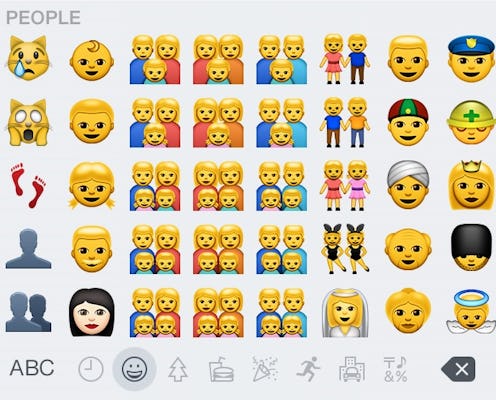News
Why Are There Still No Mixed-Race Family Emojis?

On Wednesday, Apple released the iOS 8.3 update, along with the long-awaited new racially diverse emojis. iPhone users everywhere can now change the skin color of the people emojis, which is a huge feat considering the complete lack of black or hispanic emojis (outside of the seemingly racist ones) since their creation. The update also incorporated a wide range of family make-ups, including LGBT couples with and without kids, but the attempt at diversity fell short by not merging the individual and family diversity. Yes, we need people of every shade and a range of family types, but where are the emoij families of color?
The family and couple emojis unfortunately stay the original jaundiced shade of yellow. Disregarding the fact that only very sick people's skin is actually this shade of yellow, it obviously represents white people, while more than 35 percent of Americans identify as a race other than white. The more than 1 million Americans who don't identify as white, can now text a single emoji that closely resembles their skin color, but not a couple or family. Do only white people have romantic relationships and families? Obviously not. Because of this overlooked diversity problem, Apple's emoji update only scratched the surface of inclusivity.
Going further than families of color, Apple emojis also need mixed-race couple and family options. According to the 2010 U.S. Census, 10 percent of opposite-sex marriages in the U.S. are couples of different races or ethnicities, and that doesn't even include unmarried couples or same-sex couples.
The number of interracial heterosexual married couples grew by 28 percent from 2000 to 2010, so it's certainly becoming more common for families to be made up of different skin colors. The current emojis also alienate adopted children who are a different race or ethnicity than their parents, leaving them with no adequate representation of their family.
The same-sex couple and family emojis send a positive message about LGBT acceptance, but it sadly leaves out same-sex couples of color. Representing the LGBT community was a step in the right direction, but it gives the impression that only white same-sex couples are accepted. Just as we need families of color and interracial couples, it's also crucial to include gay and lesbian couples of color. The app can't claim inclusion while only representing some aspects of diversity. Non-white couples and families deserve the ability to text an emoji representation of themselves and their relationships.
Images: Emoji (3)